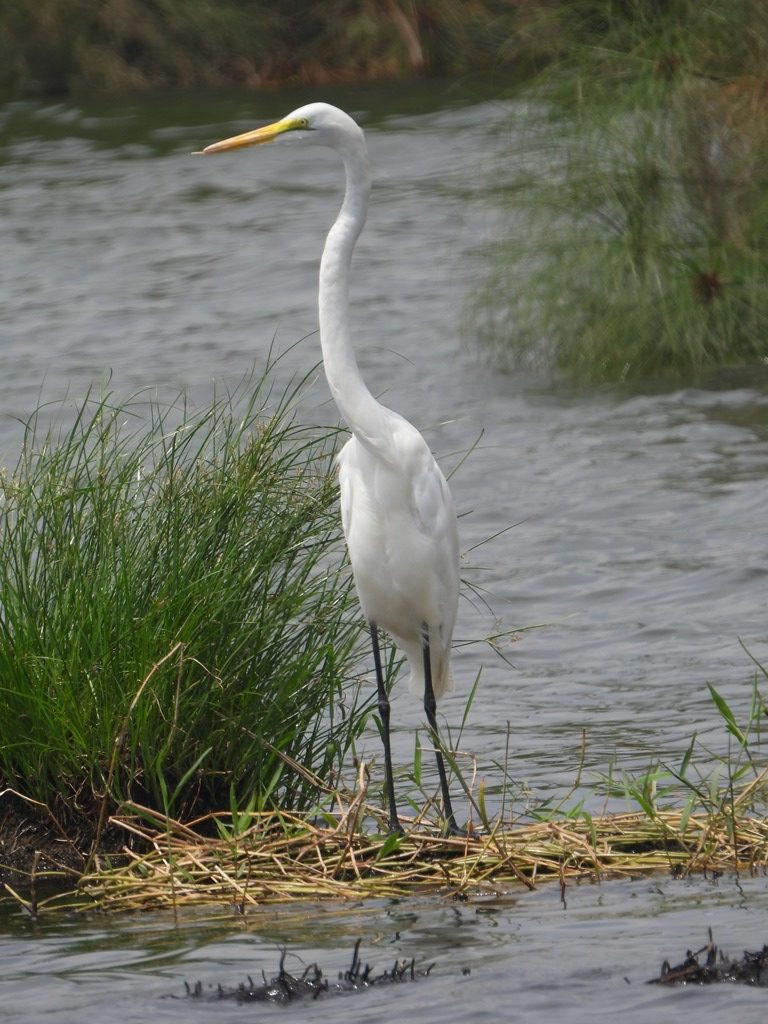Birding in Uganda
Lutembe bay wetland – a birding hotspot near Entebbe and Kampala
Lutembe bay wetland is a Ramsar site and Important Bird Area (IBA) on Lake Victoria located about 4 km off the Kampala – Entebbe highway from Namulanda. Lutembe wetland is not a popular Uganda birding destination receiving many birders, at least not as popular as the Mabamba Swamp another Lake Victoria Ramsar site famous for the Shoebill sightings. But it is a destination that will give you a wonderful check list of many species including some of the hard to find ones.
Lutembe bay being a wetland on Lake Victoria is home to lots of water and wetland associated birds, however the site extends beyond the papyrus filled lake shore to cover more wooded grasslands, thickets and gardens which contribute to a high diversity and volume of birds in Lutembe area. Lutembe area has more than 200 species of birds. The wetland is home to 8 of the 12 Lake Victoria biome species in Uganda. From September to March is perhaps the best time for birding and recording a big list at Lutembe as during this time there are many Palearctic visitors, about 26 species notably White-winged Terns, Slender-billed Gulls, Gull-billed Terns, Madagascar Squacco Heron, Greater Cormorants, and Black Heron. In addition the Paleartic visitors Lutembe hosts a number of intra-African migrants.
Other than birds Lutembe has plenty of other wildlife including otters, monitor lizards, sitatungas, squirrels, and lots of snakes (black forest cobras are common sightings along the shore)

Establishing your Birding trail to Lutembe:
The most birding in Lutembe bay is done around/near the “New Lutembe Beach” and therefore your birding trail will lead towards the New Lutembe Beach after branching off the Kampala – Entebbe highway at Namulanda or from anywhere in-between Kajjansi and Namulanda as lots of the dirt roads off the highway can still lead you to Lutembe. You can start your birding right after branching off the Kampala-Entebbe highway and you can spot birds in trees & shrubs by the roadside, in bushes, marshlands, on wall fences of houses and electric wires as you travel through settlements and along various habitats. You may however find the passing cars, speeding boda-bodas (motorcycle taxis), curious onlookers, and other human activities quite inconveniencing hence you can instead drive/ride/travel for about 3.5km to Lutembe trading center/town and from here can begin a more comfortable walk and birding to the wetland which is now a few meters ahead.
The early morning is the best time to get to Lutembe as there is a lot of bird activity, as before the rising sun intensifies there are lots of insects flying around in the bushes and grasslands attracting lots of insect eating birds and make easy to spot as they feast on the insects.
You will browse the woodlands, bushes and grasslands and then continue to the lake shore to spot the waders and several wetland species in the water vegetation. To continue into the lake you will take a boat trip at the “New Lutembe Beach” and it is the only place one can get a decent motorized boat/canoe in this area of Lutembe wetland. Take a boat ride into the lake, cruising along the papyrus on the edge of the lake picking a number of species and then continue into the lake to catch a spectacle of huge flocks of waders and other water species perching on mudflats on the lake and the Lutembe bay islet.
At least 2 days of birding in Lutembe would be sufficient to record up to 100 species.
Below is my list recorded at Lutembe on the global bird weekend of 17th & 18th October 2020
- Red-chested Sunbird
- White-browed Robinchat
- Snowy-headed Robinchat
- White-throated Bee-eater
- Yellow-throated Greenbul
- Black-headed Gonolek
- Yellow-rumped Tinkerbird
- Little Bee-eater
- Plain-backed Pipit
- Black-and-white Mannikin
- Slender-billed Weaver
- Pin-tailed Whyder
- Spur-winger Lapwing
- Golden-backed Weaver
- Grey-backed Fiscal
- Long-toed Lapwing
- African Jacana
- Grassland Pipit
- Blue-headed Coucal
- White-faced Whistling Duck
- Yellow-billed Duck
- Long-tailed Cormorant
- Yellow-throated Longclaw
- Northern Black Flycatcher
- Fawn-breasted Waxbill
- Malachite Kingfisher
- Rufous-naped Lark
- Northern Crombec
- Grey-capped Warbler
- Brown-throated Wattle-eye
- Broad-billed Roller
- Common Sandpiper
- Wood Sandpiper
- Lizard Buzzard
- Palmnut Vulture
- Helmeted Guineafowl
- African Wattled Lapwing
- Swamp Flycatcher
- Fan-tailed Widowbird
- Winding Cisticola
- Sooty Chat
- Croaking Cisticola
- Yellow-backed Weaver
- Blue-breasted Bee-eater
- Green-headed Sunbird
- Grey-headed Nigrofinch
- Great Blue Turaco
- Yellow-fronted Tinkerbird
- African Blue-Flycatcher
- Blue-spotted Wood-dove
- Brown-crowned Tchagra
- Tawny-flanked Prinia
- Laughing Dove
- Yellow-breasted Apalis
- Willow Warbler
- Spotted Flycatcher
- Purple Heron
- Great Heron
- African Pygmy Kingfisher
- Yellow Wagtail
- White-chinned Prinia
- Barn Swallow
- Grey-crowned Crane
- Giant Kingfisher
- Common Waxbill
- African Golden-breasted Banting
- Red-headed Lovebird
- White-headed Sawing
- Black-shouldered Kite
- Diederik’s Cuckoo
- Klass’s Cuckoo
- Whinchat
- Wattled Starling
- Black-and-white Shrike Flycatcher
- Marsh Harrier
- Glossy Ibis
- Common Ringed Plover
- Nubian Woodpecker
- African Green Pigeon
- Northern Puffback
- Mosque Swallow
- Stripped Kingfisher
- Yellow Fronted Canary
- Brimstone Canary
- Grossbeak Weaver
- White-winged Tern
- Whiskered Tern
- Gull-billed Tern
- Lesser Black-backed Gull
- Grey-headed Gull
- Little Stint
- Common Greenshank
- Black-winged Stilt
- Common Squacco Heron
Is it possible to see the Shoebill at Lutembe?
The Shoebill is a known inhabitant of wetlands on Lake Victoria in Uganda and so it would not be far-fetched to expect it at Lutembe. According the locals here the Shoebill (locally called boolwe) was a regular sighting when they went out fishing and sometimes would spot it from the shore, but that it has been ages since a shoebill was last sighted at Lutembe hence chances of spotting this unique bird at Lutembe is very minimal at the moment leaving Mabamba wetland as the best spot near Entebbe and Kampala if you wish to tick it off your list.




